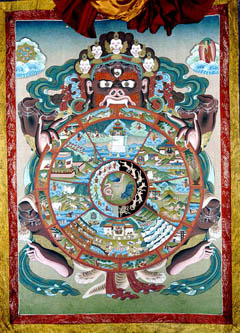Mr. John De Lisa
Religious Studies Department
St. Joseph Hill Academy
Staten Island, New York
Lesson 1
Home
 This
implementation plan is designed for the students of St. Joseph Hill Academy,
an all-girls Catholic high school on Staten Island, New York City's smallest
borough. As a Catholic school, St. Joseph Hill requests that each student
engage in a four-year curriculum of religious studies. In senior year
the students have the opportunity to elect a semester's term of World
Religions, a college extension course, for which they may receive three
credits applicable to accredited, participating institutions throughout
the United States. My training as a Catholic theologian has concentrated
primarily upon systematics, that is, dogmatic theology. Accordingly, my
interest in the institute Culture and Religions of the Himalayan
Region sought both to broaden and deepen my understanding and appreciation
of those religious traditions indigenous to the Himalayan region. The
institute has not disappointed me. It has provided me with the opportunity
to explore the reciprocal relationships between religions, intersecting
cultures, and habitats. My fundamental concern is to convey my own critically
informed experience and insights with my students who, possessed with
intelligence and wholesome curiosity, deserve a well-planned and academically
challenging presentation.
This
implementation plan is designed for the students of St. Joseph Hill Academy,
an all-girls Catholic high school on Staten Island, New York City's smallest
borough. As a Catholic school, St. Joseph Hill requests that each student
engage in a four-year curriculum of religious studies. In senior year
the students have the opportunity to elect a semester's term of World
Religions, a college extension course, for which they may receive three
credits applicable to accredited, participating institutions throughout
the United States. My training as a Catholic theologian has concentrated
primarily upon systematics, that is, dogmatic theology. Accordingly, my
interest in the institute Culture and Religions of the Himalayan
Region sought both to broaden and deepen my understanding and appreciation
of those religious traditions indigenous to the Himalayan region. The
institute has not disappointed me. It has provided me with the opportunity
to explore the reciprocal relationships between religions, intersecting
cultures, and habitats. My fundamental concern is to convey my own critically
informed experience and insights with my students who, possessed with
intelligence and wholesome curiosity, deserve a well-planned and academically
challenging presentation.
My vision is to develop a curricular unit which will explore the religious response of two basic Eastern religious systems (Buddhism and Hinduism) to the phenomenon of human existence. This unit will comprise three lessons dealing respectively with the "habitat" of human life -- a lesson originating in the geological formation of the Himalayas, and then extrapolating into the Himalayan region as metaphor for human existence; next, the physically transcendent, life-negating response to the sensory world as evidenced in Tibetan Buddhism; and, finally, the presentation of the necessarily complementary response of wisdom or life-affirmation as witnessed in Gangetic Hinduism. As is evident, this unit's approach is thematic, utilizing only selective components of the exemplary religions. This unit, then, will serve as an introductory vehicle, allowing my students ample space to pursue broader and more focused elements of these religions in their follow-up projects.
This site was created by Mr. John De Lisa at the NEH Summer Institute "Cultures and Religions of the Himalayan Region," held at the College of the Holy Cross, Summer 2004